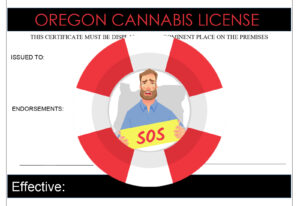Patents are increasingly a significant proportion of a cannabis company’s claimed valuation. As cannabis companies identify ways to differentiate their business from competitors, patents play an important role in ensuring that competitors cannot duplicate their products or processes.
Patents are often used to insulate products from direct competition by building temporary barriers to prevent competitors from using the same advantages. Companies can also build portfolios of patented technology that can be sold or licensed like any other asset, or used to enhance their valuation for acquisition or investment.
Not all patents, however, are created equal. Patents are supposed to be issued only for new and useful inventions, but many conflicts and self-sabotaging policies are built into the patent system that frequently result in “bad” patents–in all fields of technology–that would be invalidated if ever enforced. These patents look like all others at first glance, but they have no practical value. On the other hand, highly defensible patents may be practically worthless because they have no commercial applicability.
Involving a patent attorney who is familiar with the industry’s technology can significantly increase your ability to evaluate the worth of a patent or portfolio.
When reading and evaluating the value of a patent, whether in cannabis or any other field, there are four main considerations:
1) What do the patents actually cover?
Evaluating a patent’s scope of coverage is a two-step process. Step one is to determine what products or processes are covered by the specific language of the patent claims. Patents are technically dense documents that often seem much broader than they really are.
The idiosyncratic language and nuanced technicalities of patent law make patents difficult to understand for non-patent professionals, even experienced lawyers or scientists. Seemingly minute changes in language (i.e., “comprising” vs. “consisting of”) can have enormous consequences on what technologies are covered by the patent.
The second step of patent interpretation is to identify any “hidden” limitations on the patent’s scope. Frequently, and for a variety of reasons, a patent’s actual coverage may be significantly narrower than the explicit words of the patent. This typically results from the applicant making arguments or amendments during the lengthy application process.
The patent application process often lasts several years and involves dozens of communications between the applicant and the patent office. Applicants often make arguments to distinguish their invention from previous inventions in the hopes of convincing the patent office to grant them a patent. Under certain circumstances, those arguments can dedicate some aspects of the invention to the public and later be used against the patentee if they try to assert their patent rights.
Determining the patented subject matter is a critical step in valuing any patent and cannabis patents are no exception.
2) Is the patented technology valuable to the industry?
Not every patent is valuable. The application and examination process is supposed to ensure that patents are awarded only for “new” and “useful” inventions, but there is no requirement that the invention be commercially viable.
Patents may issue that have no practical value because no company is interested in making or using that technology, as in the often cited useless patent below, the Greenhouse Helmet. Or, even worse, they may be able to achieve the same (or better) results by simply making minor changes that avoid the patent claims altogether. The ease with which a competitor can “design around” patents and achieve similar results will greatly reduce the value of a patent.
It is not always easy to evaluate how valuable a particular invention is to an industry. One of the best indicators is the current commercialization of the invention. If the patentee and their biggest competitors are all using the patented technology, that is a strong indication that the technology has commercial value. On the other hand, if commercial realities or consumer preferences have limited the patented technology’s adoption, the patent may be practically worthless.
In the cannabis industry, technology is changing rapidly. There are often many different paths to the same destination. Whether a patented new method, composition, formulation, or device has any commercial value is a matter of whether the technology provides substantial reduction in production costs or increase in consumer demand. Proper valuation of cannabis patents therefore requires deep technical understanding of the cannabis supply chain.
3) Do major validity threats exist?
The biggest threat to any patent in any field is prior art. Prior art refers to any printed publication (typically patents and academic papers) or use of an invention before the patent’s filing date. Patented inventions are supposed to be “novel” and “nonobvious,” meaning that they represent a non-trivial advancement of public knowledge. Evidence that the invention was known or in public use prior to the application’s filing date (i.e., that it was prior art) can invalidate or limit the scope of a patent.
Identifying all potentially invalidating prior art, however, is difficult, if not impossible. High-stakes patent litigation will often uncover seemingly buried prior art, like the only copy of a doctoral thesis housed in a German library. Patent search companies can also look through commercial and proprietary databases to identify potentially relevant prior art, but that process can be expensive and is not guaranteed find all references.
Finding invalidating prior art is especially challenging in the cannabis industry, where federal prohibition has significantly limited traditional forms of prior art. In many cases, the inventions were used for years prior to filing but were not published in traditional sources. Examiners and search firms generally do not check future4200.com, Reddit, or dark web forums for cannabis prior art. To have any practical value, therefore, prior art searches for cannabis inventions must be carefully tailored to both the technology and industry segment.
4) Were critical patentability and ownership requirements met?
Aside from prior art, the biggest threats to a patent’s value are the technical requirements of the patent’s ownership and priority claims.
Ownership is perhaps the most obvious. In the U.S., patent rights belong to the inventors and are not automatically transferred to their employers. It is important to review assignment records to verify that the purported owner actually possesses those rights.
Patent priority is somewhat less intuitive than ownership, but it can have a big impact on a cannabis patent’s validity. Applicants can file multiple related applications on different aspects of the technology. Applications with an intact priority chain are entitled to the benefit as if they were filed on the earliest application date with the claimed subject matter. The earlier the priority date, the more likely the patent will withstand prior art challenges.
Failure to file the appropriate documents at the appropriate time can break the priority chain and result in a much later priority date. This is especially problematic in cannabis patents, where the bulk of prior art has been published in the last decade. Losing 1-2 years of priority could result in dozens of additional prior art references coming into play.
Takeaways
More and more patents covering cannabis technology issue every week. In all industries, but especially cannabis, it is vital to pair patent law expertise with technical understanding of the industry. The four questions above should be carefully considered in all situations where patent valuation is at issue.


























